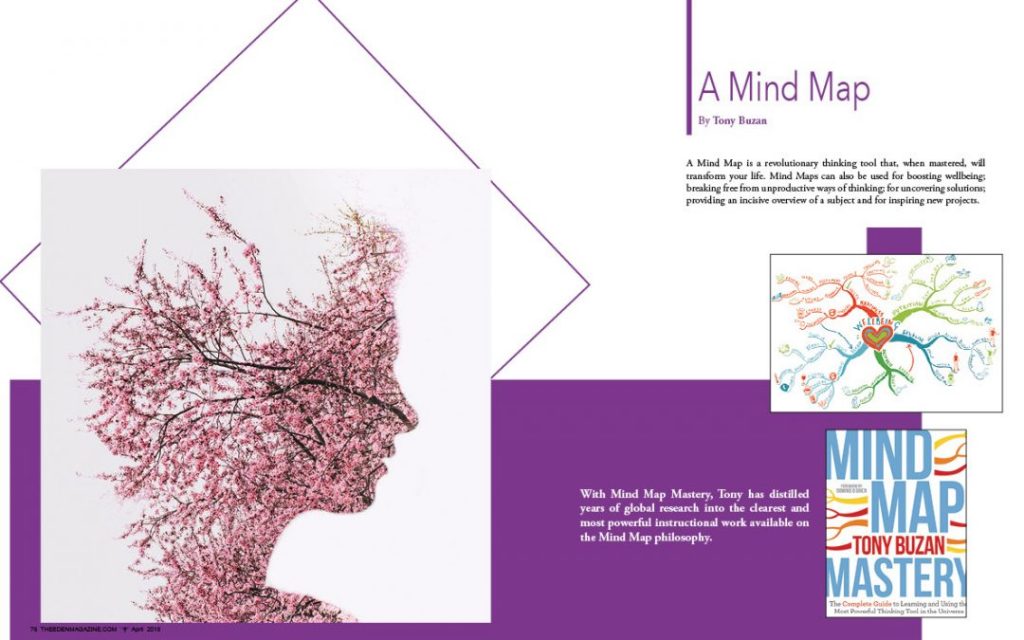By Tony Buzan
A Mind Map is a revolutionary thinking tool that, when mastered, will transform your life. Mind Maps can also be used for boosting wellbeing; breaking free from unproductive ways of thinking; for uncovering solutions; providing an incisive overview of a subject and for inspiring new projects.
What Is a Mind Map?
A Mind Map is a colorful, creative diagram that uses branches, words and images. It mirrors the structure of the brain’s neural network, with branches that reach outward from the center of the diagram and evolve through patterns of association. This structural link with the workings of the brain is one reason why Mind Mapping is so effective. To create a good Mind Map, you need to follow these ten Laws of Mind Mapping:
1. Always use a blank sheet of paper, placed in landscape position. Make sure the sheet is large enough to allow you to create sub-branches and sub-sub-branches.
2. Draw a picture in the center of the paper, representing your subject, using at least three colours. For example, if you were using a Mind Map for wellbeing you might put an image of a heart or something to represent radiance. 3. Use images, symbols, codes and dimension throughout your Mind Map, so that your Mind Map is as creative as possible and expresses the innermost workings of your mind. Remember that no special artistic skill is needed to create a good Mind Map, the important thing is the meaning the images have for you.
4. Select keywords and write these using capital letters.
5. Place each word or image on its own branch, so that it stands by itself.
6. Radiate flowing branches out from the central image. Make the branches thicker toward the centre of the Mind Map (these express the key themes), and thinner as they radiate outward into sub-branches.
7. Keep branches the same length as the words or images on them.
8. Use colours throughout the Mind Map, developing your own colour code in the branches.
9. Use emphasis, arrows and connecting lines to depict associations between different related topics in your Mind Map.
10.Aim for clarity in your Mind Map by positioning your branches in carefully thought-through space. Remember that the space between things is often as important as the things themselves. Imagine, for example, the space between trees in a forest: your brain negotiates these gaps to understand where you are and where you are going, rather than the trees.
Achieve Holistic Wellbeing
These days we understand that getting in great shape is not about focusing solely on exercise and restrictive diets, but about promoting all-round wellbeing, including nourishing our bodies properly, getting enough sleep, distressing and doing the things that make us happy. The good news is that you don’t have to spend a fortune on the services of a personal trainer or a lifestyle coach to help you feel and look great. Instead, use a Mind Map to create a personal holistic wellbeing plan of your own. Try to create images that will inspire you by radiating vitality and good health. Your main branches could reflect the key areas that contribute to your all-round wellbeing – the example below explores nutrition, exercise, distressing, sleep and happiness, but you might choose to focus on slightly different areas. As you fill in the sub-branches, looking at what supports your overall wellbeing and what hinders it, you will see how certain activities benefit you in many different ways. Perhaps exercise crops up not only as a wellbeing target of its own but also as a means of getting more sleep and distressing, which in turn helps promote happiness. In my experience, mental health and physical fitness are inextricable. The more you work on your Mind Map, the more it will speak to you and offer you all the coaching you need!
Eat Well
A more targeted Mind Map can also be used for nutrition, to make sure that you eat a healthy diet that includes a balance of all the major food groups (carbohydrates, proteins, dairy, fruit and vegetables, and fats and sugars). You can use a Mind Map as a weekly meal planner by adapting your personal weekly planner Mind Map to focus on food rather than activities. The sub-branches could list the day’s main meals, spreading out to detail the ingredients of each meal, along with its nutritional value. If you create a Mind Map focusing on eating well at the start of each week, you’ll provide yourself with a handy shopping list. Then you can frame your magnificently illustrated Mind Map and hang it on the wall as a guide and inspiration to ensure you always eat a balanced and varied diet.
Tony Buzan invented the Mind Map technique five decades ago. Tony Buzan’s work on Mind Maps has been published in over 30 languages and 100 countries. There are many books on Mind Maps, but this is the most complete volume from Mind Maps inventor Tony Buzan. Tony Buzan is also the author of the multi-million-copy bestselling How to Mind Map and Mind Maps for Kids series. He appears regularly on television, radio and in print, and lectures all over the world. He advises international businesses, governments, educational authorities and Olympic athletes. Mind Map Mastery is available through Amazon and all good bookstores from March 15th.







